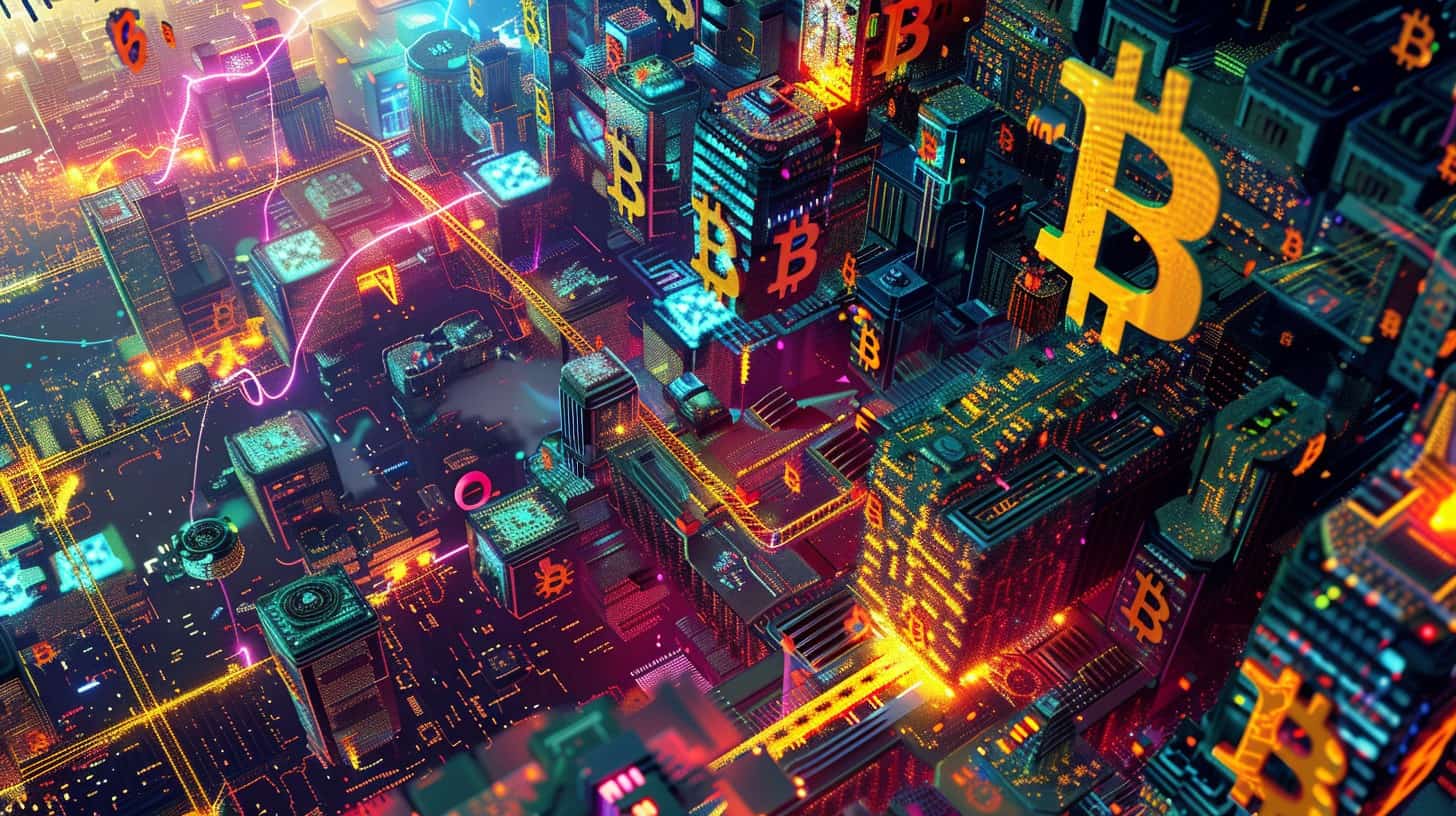High transaction fees and slow processing times plague many blockchain networks. 3 A Layer 2 solution can solve these issues by improving speed, reducing costs, and enhancing scalability. 2 This article will explore how Layer 2 solutions provide a more efficient means of processing transactions without compromising security.
With years of experience in blockchain technology, I’ve seen how critical it is to understand the differences between Layer 1 and Layer 2 scaling solutions. They aim to enhance the performance of blockchain networks like Bitcoin and Ethereum significantly. 1 Ready to unlock the secrets behind faster and cheaper transactions? Dive into this guide packed with practical insights!
Key Takeaways
Layer 2 solutions like rollups, side chains, and state channels enhance blockchain performance by increasing transaction speed and reducing costs without compromising security.
Rollups can boost Ethereum’s transaction capacity to over 100,000 transactions per second (TPS) from the current limit of about 15 TPS.
Side chains operate independently of the main blockchain but improve user experience with near-instant finality and scalability; Total Value Locked (TVL) in side chains reached $8.49 billion in May 2023.
The Lightning Network significantly speeds up Bitcoin transactions, making payments almost instant while locking nearly $145 million worth of BTC into its network.
ZK-Rollups use zero-knowledge cryptography to reduce gas fees on Ethereum while ensuring fast processing; projects like zk-Sync Era and Polygon zkevm illustrate this method’s efficiency.
Table of Contents
What is Layer 2 in Cryptocurrency?

Layer 2 in cryptocurrency refers to a second layer built on top of an existing blockchain, like Ethereum or Bitcoin. This layer handles transactions off the main chain to increase speed and reduce costs.
Layer 2 solutions include rollups, side chains, and state channels. 1
Rollups bundle many transactions and post them to the main chain as one lump. Side chains run parallel to the main chain but use their own consensus mechanisms. State channels let users transact off-chain directly between each other without waiting for block confirmations.
Popular Layer 2 networks include Arbitrum, Optimism, zk-Sync, and Lightning Network.
These solutions make crypto more scalable by allowing more people to use it at once without slowing down transaction times or increasing fees. The Optimism price forecast for 2025 from CoinDataFlow predicts significant growth due to these enhancements. 2 This allows for faster payments and lower gas fees while keeping the same level of security as the main blockchain.
Differences Between Layer 1 and Layer 2

Layer 1 processes transactions directly on the main blockchain. Layer 2 works above it, improving speed and cutting costs.
Scalability
Scalability in blockchain means handling more transactions quickly. Ethereum Layer 1 can only process 20–30 transactions per second (TPS), but Layer 2 solutions can handle up to 40,000 TPS. 1 Bitcoin’s Layer 1 manages about seven TPS… This makes it slow for a large number of users.
Layer 2 improvements boost scalability by taking some tasks off the main chain. Rollups, side chains, and state channels are examples that help increase transaction speed and cut costs. 3 Speaking about Ethereum scalability:
Layer 2 solutions enable faster and cheaper transactions on the network.
Next: Speed…
Speed
Layer 2 solutions offer unparalleled speed. Lightning Network transactions on the Bitcoin blockchain are nearly instant and inexpensive—often under a second. 4 Optimistic rollups for Ethereum can reduce transaction costs to under $0.20 per transaction, speeding up processing times.
Side chains also enhance speed by handling many transactions off the main chain. 1 State channels provide another method where two parties can transact faster without waiting for block confirmations.
This makes interactions smoother and much quicker than Layer 1 solutions like proof-of-work (PoW).
Cost
Using a Layer 1 blockchain like Ethereum can be expensive. Mining and transfers cost between $50 to $125 per day. 5 That’s steep! Now, think about the Polygon Layer 2 blockchain.
Minting and transfers there are just around $0.05. This is much more affordable for users.
Optimistic Rollups and ZK-Rollups play a big role in cutting these gas fees down. They bundle many transactions together before posting them back to the main chain, saving lots of money…
1 Next up is how these solutions speed things up!
Types of Layer 2 Scaling Solutions

Types of Layer 2 Scaling Solutions: Learn about the different methods to make cryptocurrency faster and cheaper…
Rollups
Rollups bundle many transactions into one. This boosts processing capacity, making it possible to handle up to 40,000 transactions per second (TPS). Optimistic rollups work by assuming all proposed transactions are valid.
They include a challenge period where any invalid transaction can be disputed. 6
ZK-Rollups use zero-knowledge proofs (zk-snarks and zk-stark) to verify that each transaction is true without revealing details. Rollups reduce gas fees on Ethereum by moving most of the data off-chain while keeping security strong with cryptographic signatures.
These improvements lead to lower costs, faster speeds, and better scalability for decentralized finance applications using smart contracts on networks like Polygon zkevm and zkSync Era. 7
Side Chains
Side chains, unlike rollups, operate as independent blockchain networks. These have their own set of validators. They offer near-instant transaction finality and vastly improve user experience. 1 For example, Polygon and Optimism provide solutions that enhance network performance.
Polygon transforms Ethereum into a full-fledged multi-chain system. – Vitalik Buterin
In May 2023, the Total Value Locked (TVL) in side chains reached $8.49 billion. 8 This shows the strong adoption and trust within the crypto community. Entities like Arbitrum and Starknet also keep innovating to support scalability, speed, and cost efficiency in cryptocurrency transactions.
State Channels
After side chains, we need to look at state channels. They record transactions off-chain in bulk and then broadcast the completed “state” to the main network. This method offers high throughput, instant transactions, reduced costs, and greater privacy. 9
Opening a channel requires submitting an initial state to the blockchain. Closing a channel involves sending the final state of off-chain transactions back to the main blockchain. 10
How Layer 2 Solutions Enhance Ethereum

Layer 2 solutions make Ethereum faster and cheaper. They handle more transactions without changing the main blockchain….
Increased Transaction Throughput
Layer 2 solutions boost Ethereum’s transaction capacity. Current Limit: about 15 transactions per second (TPS). Rollups, a Layer 2 method, can push this up to over 100,000 TPS. 12 This is huge for decentralized finance (DeFi) and other crypto applications.
Sharding also helps by splitting the network to handle many tasks at once. 11
This increased throughput means less waiting time—transactions get processed faster. It makes Ethereum more user-friendly and efficient. Innovations like the Dencun upgrade make these transactions cheaper too. 11 Reducing gas fees is key! High speeds plus low costs are good news for everyone using blockchain tech.
Reduced Gas Fees
Ethereum Layer 1 gas fees averaged over $7 in 2023. Layer-2 solutions, like Optimistic Rollups such as Arbitrum and ZK-Rollups, reduce these high fees. They offload transactions from the main blockchain while maintaining security through cryptographic proofs. 13
Optimistic Rollups process most transactions off-chain to save costs and boost speed. ZK-Rollups also use off-chain processing but add an extra layer of security with cryptographic proofs.
These methods make decentralized finance more accessible by cutting down on transaction-processing expenses. 14
Improved User Experience
Layer 2 solutions make Ethereum easier and faster for users. These solutions increase transaction throughput, meaning more transactions happen quickly. 15 They also reduce gas fees, making it cheaper to use the network.
Users enjoy smoother interactions with smart contracts on Layer 2 networks like Rollups or Side Chains. For example, zk-Rollups offer speed and security advantages over optimistic rollups. 15 Optimistic rollups can cut transaction costs to under $0.20 per transaction, saving money.
“Optimistic Rollups are a game-changer—providing cost-effective transactions while maintaining security,” says Vitalik Buterin. 4
This makes crypto activities simpler and affordable for everyone.
Examples of Layer 2 Implementations

Layer 2 solutions improve crypto performance. For example, the Lightning Network speeds up Bitcoin transactions.
Lightning Network for Bitcoin
The Lightning Network boosts Bitcoin transactions. This layer-2 solution makes payments fast and cheap. Over 5,400 BTC worth $145 million is locked into the network. 16 There are nearly 16,400 nodes and 75,700 channels in use.
Transactions on this network happen almost instantly… Costs drop significantly, too! 17 The system uses cryptography to ensure security. Users enjoy better speed without losing trust in the blockchain technology.
Optimistic and zk-Rollups for Ethereum
Optimistic Rollups assume transactions are valid by default and use a fraud-proving system. 18 They enhance Ethereum by increasing speed and lowering costs without compromising security.
Notable projects include Optimism, Arbitrum, and Base. These provide scalable solutions with thousands of transactions per second.
ZK-Rollups rely on zero-knowledge cryptography to ensure transaction validity through SNARKs (Succinct Non-interactive Arguments of Knowledge). 19 This method boosts Ethereum’s efficiency while reducing gas fees significantly.
Major ZK-Rollups projects are LINEA, SCROLL ZKEVM, and STARKNET.
The Future of Layer 2 Solutions

New Layer 2 solutions are coming to make blockchain faster and cheaper. These updates will help cryptocurrencies grow and stay secure.
Potential Developments
Layer 2 solutions could push Ethereum’s transaction speed to 100,000 TPS. 20 Bitcoin might hit 1,000,000 TPS with the Lightning Network. Rollups are key for blockchain scalability—they bundle transactions together. 21
Decentralizing Layer 2 systems is vital. This step will boost security and efficiency. Developers work on reducing gas fees and improving user experience on the Ethereum network…
New cryptographic methods like zkps may enhance privacy and security further.
Challenges Ahead
Security trade-offs pose real risks. Faster and cheaper transactions can weaken security. Centralization in Layer 2 rollups concentrates power in a few operators, causing vulnerabilities.
A significant challenge arises with blockchain forks; they splinter communities and confuse users.
High gas fees and slow speeds frustrate many Ethereum users. Attempts to scale the network often introduce complexities that compromise its security. Bitcoin struggles similarly, with sluggish transaction times creating friction for everyday use.
Decentralized finance needs solutions that balance speed, cost, and safety effectively to thrive in the future of finance. 321
People Also Ask
What is a Layer 2 in crypto?
A Layer 2 in crypto is an overlaying network that works on top of the main blockchain, like Bitcoin or Ethereum. It helps improve speed and scalability.
How does a Layer 2 solution help with scalability?
Layer 2 solutions reduce the load on the main blockchain by processing transactions off-chain. This saves computational power and speeds up transaction times.
Are there different types of Layer 2 solutions?
Yes, examples include sidechains and state channels. These methods use various consensus algorithms like Proof-of-Stake (PoS) to ensure security while enhancing performance.
Can Layer 2 solutions be used for all cryptocurrencies?
Layer 2 can work with many cryptocurrencies such as Bitcoin, Ethereum, and Litecoin. Each has specific implementations tailored to its unique needs.
Is it safe to use Layer 2 solutions?
Yes, they are designed to be secure using cryptographically signed transactions and tamper-proof mechanisms to maintain authenticity.
Do I need special hardware for using Layer 2 solutions?
No special hardware is required; standard devices can handle these tasks efficiently without needing application-specific integrated circuits (ASICs).
References
- ^ https://www.investopedia.com/what-are-layer-1-and-layer-2-blockchain-scaling-solutions-7104877
- ^ https://www.forbes.com/sites/danielgoldman/article/what-is-a-crypto-layer-2-and-how-does-it-work/ (2023-06-18)
- ^ https://zenledger.io/blog/the-promise-of-blockchain-scalability-with-layer-2-solutions/
- ^ https://tokenminds.co/blog/blockchain-development/layer-2-solutions (2024-03-27)
- ^ https://www.threekit.com/blog/whats-difference-between-layer-1-layer-2-blockchains (2022-01-26)
- ^ https://wiki.polkadot.network/docs/learn-comparisons-rollups
- ^ https://coinmarketcap.com/alexandria/article/what-are-cryptocurrency-layer-2-scaling-solutions
- ^ https://blaize.tech/article-type/overview/a-comprehensive-guide-on-blockchain-layer-2-scaling-solutions/ (2023-05-31)
- ^ https://antematter.io/blogs/layer-2-state-channels-blockchain-guide (2024-04-23)
- ^ https://crypto.com/university/what-are-layer-2-scaling-solutions (2022-08-12)
- ^ https://www.studentcoin.org/coinpaper/ethereum-scaling-solutions-unlocking-greater-efficiency-and-speed
- ^ https://explore.m2.com/learn/what-are-ethereum-layer-2-blockchains-and-how-do-they-work (2024-05-14)
- ^ https://www.covalenthq.com/docs/unified-api/guides/how-layer-2-blockchains-solve-ethereum-s-scalability-dilemma/
- ^ https://shardeum.org/blog/ethereum-blobs-layer-2-gas-savings/
- ^ https://www.fidelitydigitalassets.com/research-and-insights/rise-layer-2-scaling-ethereum (2023-05-11)
- ^ https://cointelegraph.com/learn/what-is-the-lightning-network-in-bitcoin-and-how-does-it-work (2023-08-16)
- ^ https://dci.mit.edu/lightning-network
- ^ https://tokenminds.co/blog/knowledge-base/optimistic-rollups-vs-zk-rollups
- ^ https://www.gemini.com/cryptopedia/layer-2-scaling-zk-rollup-optimistic-rollup-ethereum
- ^ https://www.linkedin.com/pulse/exploring-future-blockchain-scaling-layer-2-solutions-krzysztof-gogol
- ^ https://medium.com/@spockofcrypto/layer-2-scaling-solutions-the-future-of-blockchain-scalability-f694ddffdd12



